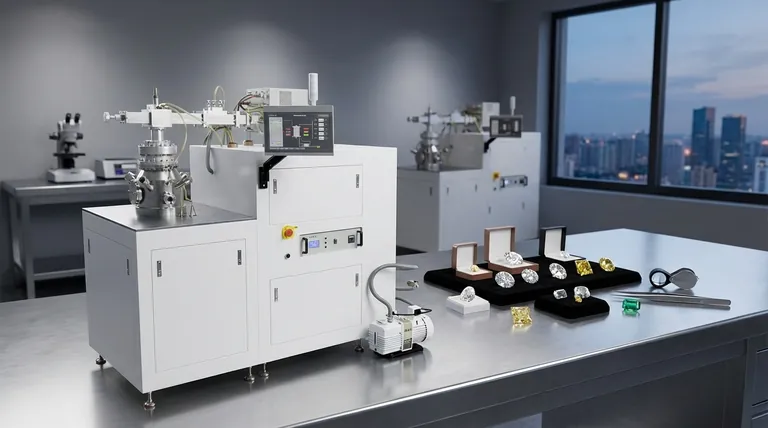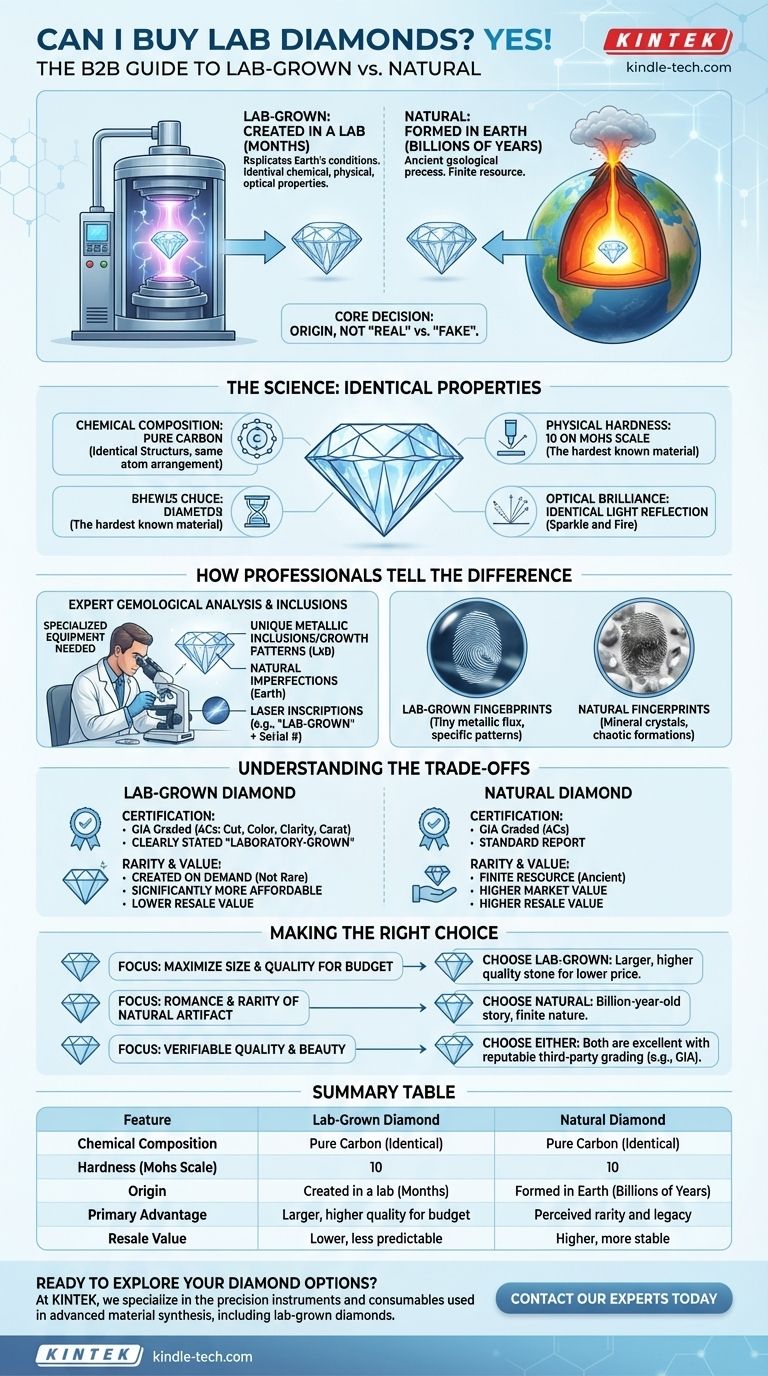Yes, you can absolutely buy lab-grown diamonds. They are widely available from jewelers and online retailers. A lab-grown diamond is chemically, physically, and optically identical to a diamond mined from the Earth, sharing the same hardness, brilliance, and crystal structure. To the naked eye, they are indistinguishable from one another.
The core decision is not about choosing a "real" versus a "fake" diamond. Both are real. The choice is about origin—valuing a stone created over billions of years by the Earth versus one created in months through human ingenuity.

What Exactly Is a Lab-Grown Diamond?
Understanding the fundamental nature of a lab-grown diamond is key to making an informed decision. They are not imitations; they are diamonds created through a different process.
Identical Chemical and Physical Properties
A lab-grown diamond is not a simulant like cubic zirconia or moissanite. It is composed of pure carbon atoms arranged in the same crystal structure as a natural diamond.
This means it has the same exceptional hardness (a 10 on the Mohs scale), the same light-reflecting properties that create sparkle, and the same overall appearance.
The Creation Process: Lab vs. Earth
The primary difference lies in their formation. Natural diamonds formed deep within the Earth's mantle between 1 and 3.3 billion years ago under immense heat and pressure.
Lab-grown diamonds replicate these conditions in a highly controlled environment, growing a diamond from a "seed" crystal in a process that takes several months.
How Professionals Tell the Difference
While you cannot see a difference, trained gemologists using specialized equipment can identify a diamond's origin. This ensures transparency in the market.
Expert Gemological Analysis
Distinguishing between the two types requires examining their internal characteristics. It is not something that can be done without advanced gemological tools.
Telltale Inclusions and Growth Patterns
The unique conditions of their creation leave subtle "fingerprints." Lab-grown diamonds often have tiny metallic inclusions or specific crystal growth patterns that are absent in natural diamonds.
Conversely, natural diamonds contain different types of imperfections that reflect their chaotic, billion-year formation deep within the Earth.
Disclosure and Laser Inscriptions
Reputable jewelers will always disclose whether a diamond is lab-grown or natural. Furthermore, many lab-grown diamonds are laser-inscribed on their girdle with a unique serial number and often the words "lab-grown" to ensure clear identification.
Understanding the Trade-offs
Choosing a lab-grown diamond involves a different set of considerations regarding certification and long-term value compared to a natural diamond.
Certification and Grading
Major gemological labs, including the Gemological Institute of America (GIA), grade lab-grown diamonds using the exact same rigorous standards as natural diamonds.
They receive a full assessment of the 4Cs (Cut, Color, Clarity, and Carat). However, the report will clearly state that the diamond is "Laboratory-Grown," providing full transparency.
Rarity and Value
Natural diamonds are a finite resource, a product of ancient geology, which is a major factor in their market value and rarity.
Because lab-grown diamonds can be created on demand, they do not possess the same rarity. This makes them significantly more affordable but also means their long-term resale value is lower and less predictable than that of a natural diamond.
Making the Right Choice for Your Goal
The best option depends entirely on your personal priorities.
- If your primary focus is maximizing size and quality for your budget: A lab-grown diamond will provide a larger, higher-quality stone for a lower price than a natural diamond of the same specifications.
- If your primary focus is the romance and rarity of a natural artifact: A mined diamond, with its billion-year-old story and finite nature, is the only choice that will satisfy this goal.
- If your primary focus is verifiable quality and beauty: Both lab-grown and natural diamonds are excellent choices, provided you purchase one with a reputable third-party grading report like those from GIA.
Ultimately, you are choosing between the legacy of a natural gem and the modern innovation of a scientifically identical one.
Summary Table:
| Feature | Lab-Grown Diamond | Natural Diamond |
|---|---|---|
| Chemical Composition | Pure Carbon (Identical) | Pure Carbon (Identical) |
| Hardness (Mohs Scale) | 10 | 10 |
| Origin | Created in a lab (Months) | Formed in Earth (Billions of Years) |
| Primary Advantage | Larger, higher quality for budget | Perceived rarity and legacy |
| Resale Value | Lower, less predictable | Higher, more stable |
Ready to Explore Your Diamond Options?
Whether you're drawn to the advanced technology and value of a lab-grown diamond or the timeless rarity of a natural stone, making an informed choice starts with the right equipment and expertise. At KINTEK, we specialize in the precision instruments and consumables used in advanced material synthesis, including the technologies that create beautiful lab-grown diamonds.
Let us help you achieve your goals with confidence.
Contact our experts today to discuss how KINTEK's laboratory solutions can support your journey in material science and gemology.
Visual Guide

Related Products
- Cylindrical Resonator MPCVD Machine System Reactor for Microwave Plasma Chemical Vapor Deposition and Lab Diamond Growth
- Laboratory CVD Boron Doped Diamond Materials
- CVD Diamond Domes for Industrial and Scientific Applications
- CVD Diamond Cutting Tool Blanks for Precision Machining
- CVD Diamond Optical Windows for Lab Applications
People Also Ask
- How do lab-grown diamonds compare to natural diamonds? Uncover the Truth About Origin, Price, and Value
- How to start a lab grown diamond business? Choose the Right Model for Success
- What are the limitations of diamonds? Beyond the Myth of Perfection
- How does microwave plasma work? Unlock Precision Material Synthesis for Advanced Manufacturing
- What is the difference between MPCVD and HFCVD? Choose the Right CVD Method for Your Application











